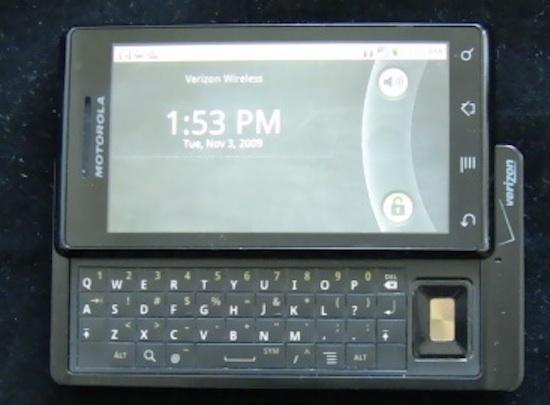
Introduction
The Motorola Droid for Verizon is a big deal. But you knew that, thanks to the "iCan't but DroidDoes" marketing blitz that Verizon has just started to unleash upon the American media in the weeks leading up to Droid hitting stores this Friday, November 6th. Verizon is positioning Droid as their "iPhone Killer," to use a beat-to-death-overused phrase, and while that positioning is rather unfortunate, it also makes sense. Verizon wants to challenge both iPhone's dominance at the top of the U.S. smartphone sales charts and AT&T's back-and-forth claim to VZW's spot atop the U.S. wireless carrier pile.
And then there's the whole Google-Apple love/hate affair, which I frankly can't quite keep up with anymore.
But I digress … Moto Droid is a big deal for Motorola, as well, as it cements the company's return to the fore of top-tier cell phone makers. Whether or not Moto will keep pace with the big boys, let alone return to the glory days of StarTacs and RAZRs remains to be seen, but Android has given Motorola new life with the T-Mobile CLIQ and Verizon Droid (just launched in Europe as the GSM "Milestone").
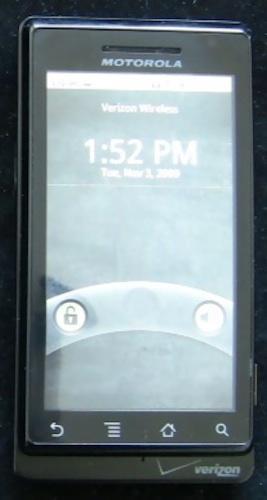
The Phone, The Device, and The Battery
I've had a Droid in hand for almost a week now. How is it? In a word, excellent. I'll save the head-to-head with iPhone 3GS for a video Dogfight, but suffice it to say that when Droid hits Verizon stores on Friday it will deserve its spot as Big Red's flagship device for the holiday season. BlackBerry users and other hard-core email/texters may not be drawn to Droid (more on that in a minute), but other smartphone users will no doubt be won over by the device's gorgeous screen, high-end features, and the usability and potential of Android OS 2.0.
First off, Droid works very well as a phone. Verizon's network performed very well for me out here in the San Francisco Bay Area, and calls came through loud and clear whether I used a headset, speakerphone, or just the phone itself. Droid has one of the louder speakers I've heard on a cell phone in recent days, as well, which is handy both for voice calls and the new Google Navigation app with its voice prompts.
Secondly, battery life has been okay, but just barely. My device has been in dire need of a recharge pretty much every night that I've had it. That said, it only ran completely out of gas during abnormally heavy testing, and my rule of thumb is that I charge my phone every night, period. Droid gets better battery life than CLIQ, but fares slightly worse than an iPhone 3GS or Palm Pre under similarly heavy but "normal" use of voice and data features. Interestingly, I've heard and read some pretty wide-ranging reports on battery life from other early reviewers, so your mileage will no doubt vary depending on use habits and network coverage in your area.
The phone is made largely from metal and glass. It feels solid in hand, and is rather large and a little bit heavy as compared to other smartphones. That's not necessarily bad, just how it is - it's still quite pocketable. Droid's slider mechanism lacks a spring hinge, but it also doesn't wobble too much. The three touch-sensitive buttons located beneath the display work just fine for me, though I'm not so sure that plain old buttons don't work better than fancy touch controls, in the long run.
As for the phone's looks? Totally a subjective thing, so judge for yourselves. Me, I think the gold accents are kind of funny, but I otherwise like the stealthy black looks of the thing.
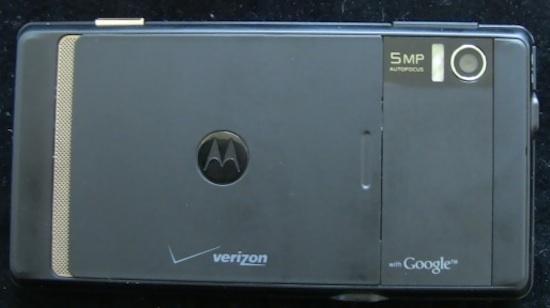
The Good: Beautiful Screen and Updated OS
Droid's best feature is its gorgeous 3.7" touchscreen display. The 16:9 widescreen renders 854 x 480 pixels at a whopping 267 pixels per inch, which means it shows more pixels than most competitors and has plenty of room for widescreen Web browsing and high-quality video watching. And the screen is just beautiful to look at. The capacitive touch system is quite responsive, as well, and supports multitouch input to a degree: multitouch on the virtual keyboard is a yes, pinch-to-zoom on the Web browser is a no, though double tap-to-zoom has been implemented.
In all honesty, Droid's display is probably the best-looking I've ever seen on a mobile phone. And the touchscreen is almost as responsive as iPhone 3GS' … but not quite. You won't notice the difference, though, unless you're obsessed with trying every cell phone on the market, so let's just say it's one of the most responsive displays out there.
Droid's next best feature is probably Android 2.0. This is quite simply the fastest, most responsive Android device I've seen to date. Yeah, yeah, I know that statement will likely only stand true for a month or so (Snapdragon, anyone?), and a Samsung Moment running 2.0 could make for an interesting race, but for now Droid's the fastest Android on the block.
Android's been more of a geek's playground than a consumer-ready platform since its inception, and while version 2.0 isn't quite as polished as some of its competitors, it's definitely much more ready for mass adoption than any 1.x version. The Web browser, contact manager, and Email clients have all seen notable upgrades and the OS itself now supports syncing with Facebook accounts in addition to Google and "Corporate" (Exchange) accounts. And the aforementioned Google Maps Navigation Beta is great. No, it's not perfect, but it's great for a Version 1 Beta, and between the solid integration with Android's voice search and the power of Google Maps behind it, it will only get better with subsequent releases. And it's free; iCan't, indeed.
Droid is notably lacking Motoblur, the widget-heavy social networking fiesta that graces CLIQ's home screens, apps, and PIM utilities. While I don't mind the lack of Blur here, having used CLIQ I do wish Droid took advantage of certain aspects of Blur - notably its rich messaging composer and RSS feed widget. Android 2.0's universal Email inbox is nice, but I like Motoblur's Messaging widget even better, as it lets me scroll through Emails and other messages without leaving the home screen. Still, Android 2.0 debuts a plug-in framework that should allow for all sorts of social network integration and other nifty widgets and add-ons that could bring some Blur-type functionality to Droid users in due time. And Droid ships with a Facebook widget that's pretty decent.
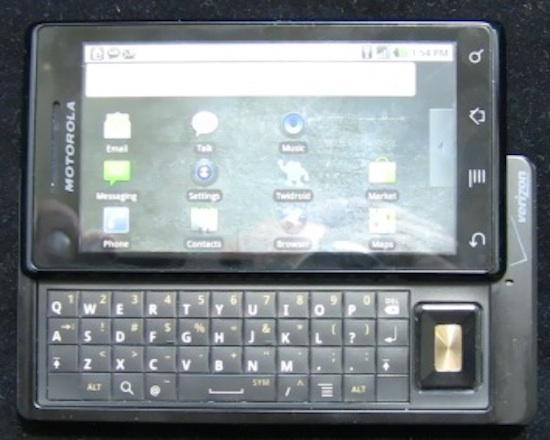
The Bad: Another Disappointing QWERTY
Droid's worst feature is its physical keyboard. Let me preface what I'm about to say with this: Phone keyboards are a very personal thing, and you may well love what I can't stand (I'm looking at you, Palm Pre users). So take my opinion for what it's worth and try the darn thing for yourselves, okay? And our own John Walton may well disagree with me when his Droid review comes out.
Okay. Now, then …
Droid's hard QWERTY board is disappointing. I love, love, love the idea of a high-end Android phone with a slide-out keyboard. I love that MOTO managed to keep Droid super-thin and sleek while still packing a real keyboard in. But I hate typing on the thing. For my money, Droid's QWERTY board is too flat and too shallow. It's also a wee bit cramped, and suffers from being oddly offset to the left thanks to the D-Pad positioned to the keyboard's left. Said offset resulted in my right thumb having to stretch over the D-Pad during typing, a minorly uncomfortable thing. But it's those flat, flat keys and that short, short travel that left my thumbs screaming for mercy after a few sentences at a time. Imagine the old HTC Touch Pro ("Tilt" on AT&T) keyboard, all grid-like and chiclet-y, but worse, and you've got Droid. CLIQ's keyboard offers contoured buttons and a bit more key travel, which makes for a slightly better experience.
The combination of Android 2.0 and Droid's huge display and limited multitouch support makes for a nice virtual QWERTY experience, except for some occasional lag. The software doesn't miss my taps, but it sometimes hangs for a second while I'm still typing, and then catches up by registering multiple letters in rapid sequence. That said, landscape and portrait modes both offer pretty good typing experiences, enhanced by user-controllable haptic feedback. Virtual QWERTY also lets you take advantage of Android's excellent autocomplete/user dictionary system, something oddly missing from the display when you're using the hard keyboard.
Experienced Android users will likely replace the virtual QWERTY, anyway, so you may well have skipped most of that last paragraph.
Personally, I'd rather see a thinner, lighter Droid with the physical keyboard lopped off. That pretty much sums up my reaction to the virtual and real QWERTY experiences offered here.
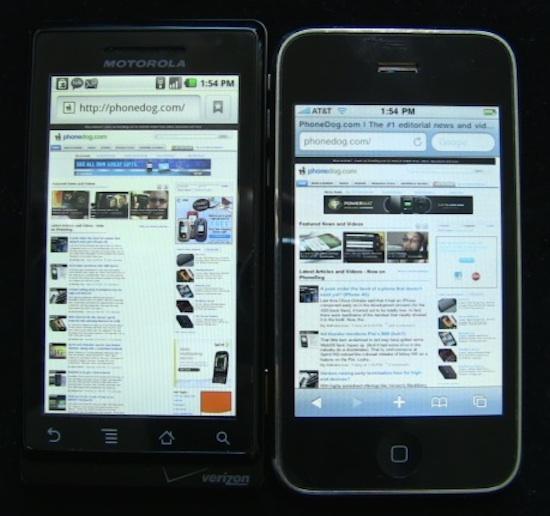
The Rest: So-So Camera, Okay Media, and Excellent Nav
What else can I tell you? Droid's camera is so-so. On the one hand you've got five megapixels, a dual-LED flash, and a great camcorder mode. On the other hand, the camera is slow to focus, slow to capture, and really slow to reload for the next shot. Compared to other Android phones, it's fine. Compared to iPhone 3GS it's slow (sorry, Verizon, you're begging for the comparisons). Photo quality was good except when the focus was kinda iffy or I missed the shot entirely waiting for the device to set up and shoot.
Droid's media player is good but not great, being Android 2.0's stock install. This is one area where customization really benefits device makers - take a look at a recent HTC Android phone or, better yet, Sony Ericsson's forthcoming Xperia X10 and you'll see what I mean. Still, I could load media onto a microSD card, pop it into Droid, and play it back. Videos looked great and music sounded great. No headset is included, but Droid supports 3.5mm wired 'phones and Stereo Bluetooth.
A 16GB microSD card is included with the phone, which is cool. The microSD slot is hidden beneath the battery cover, and you actually have to pull the battery to get the card in and out, which isn't so cool. Android also lacks a decent media sync solution, so get ready to implement the good lo' "USB drag and drop" method to manage your music, photos, and media … at least until somebody comes up with something better.
Oh yeah, Moto is also offering two accessory docks for the device: One for home and one for car. They'll run thirty bucks each. I've tried the home dock and it's pretty neat, though I wish it had audio-pass through so I could leave it hard-wired into a speaker system. Still, it more or less turns Droid into the old Verizon Hub, as you can see in this video.
And Google Navigation? Like I said, pretty awesome. I mean, it got me to frozen yogurt, as you can see in this video.
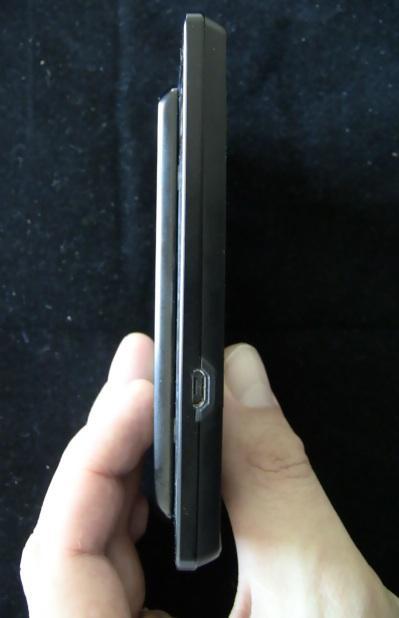
Wrap-Up: It's Very Good, This Droid
Verizon should wind up selling a bunch of these things when Droid goes on sale this Friday for $199 after rebate with a two-year contract. Motorola, Verizon, and Google have done a solid, solid job crafting the first Android 2.0 phone. iPhone haters and Verizon loyalists finally have themselves a sleek, flashy touchscreen smartphone to call their own, and everyone else has the fastest Android phone to date and their first chance to buy something with 2.0 pre-installed.
Do I recommend Droid? Yes. The usual caveats apply, and in this case I highly recommend you try the device's physical keyboard out for yourself. My thumbs didn't much care for it, but I'm sure some of you won't take quite so much issue with the setup. I wish Droid had a pinch-and-zoom Web browser like Milestone, it's European counterpart, and I wish some of those Motoblur features had crossed over to this device, too.
Would I rather have Droid than any other device on the market? Not sure I can say that. Will iPhone users leave AT&T in droves for Droid? Some will, but likely more for Verizon's network than Droid itself. Will BlackBerry users jump ship for Android on Verizon? Not if they like their BBerry's keyboards, they won't.
But is Droid an excellent smartphone? Absolutely. And if I had to use Droid and only Droid for the foreseeable future, would I be alright with that? Yep. The hardware is solid, the virtual QWERTY is there for me when my thumbs get tired, and Android 2.0 has a very promising future.
Rejoice, Android, Motorola, and Verizon fans: Droid Day is upon us and it should be a happy day, indeed.
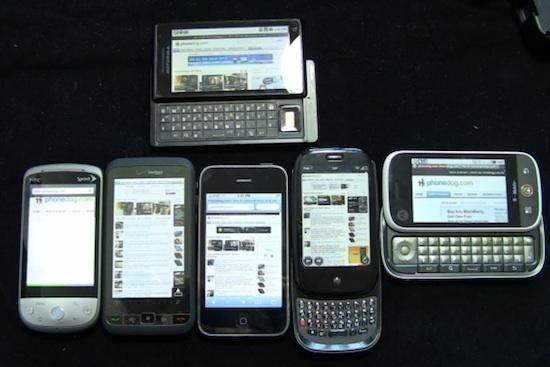
(Top: MOTO Droid; Bottom, l-to-r: HTC Sprint Hero, Verizon HTC Imagio, AT&T Apple iPhone 3GS, Sprint Palm Pre, T-Mobile MOTO Cliq)